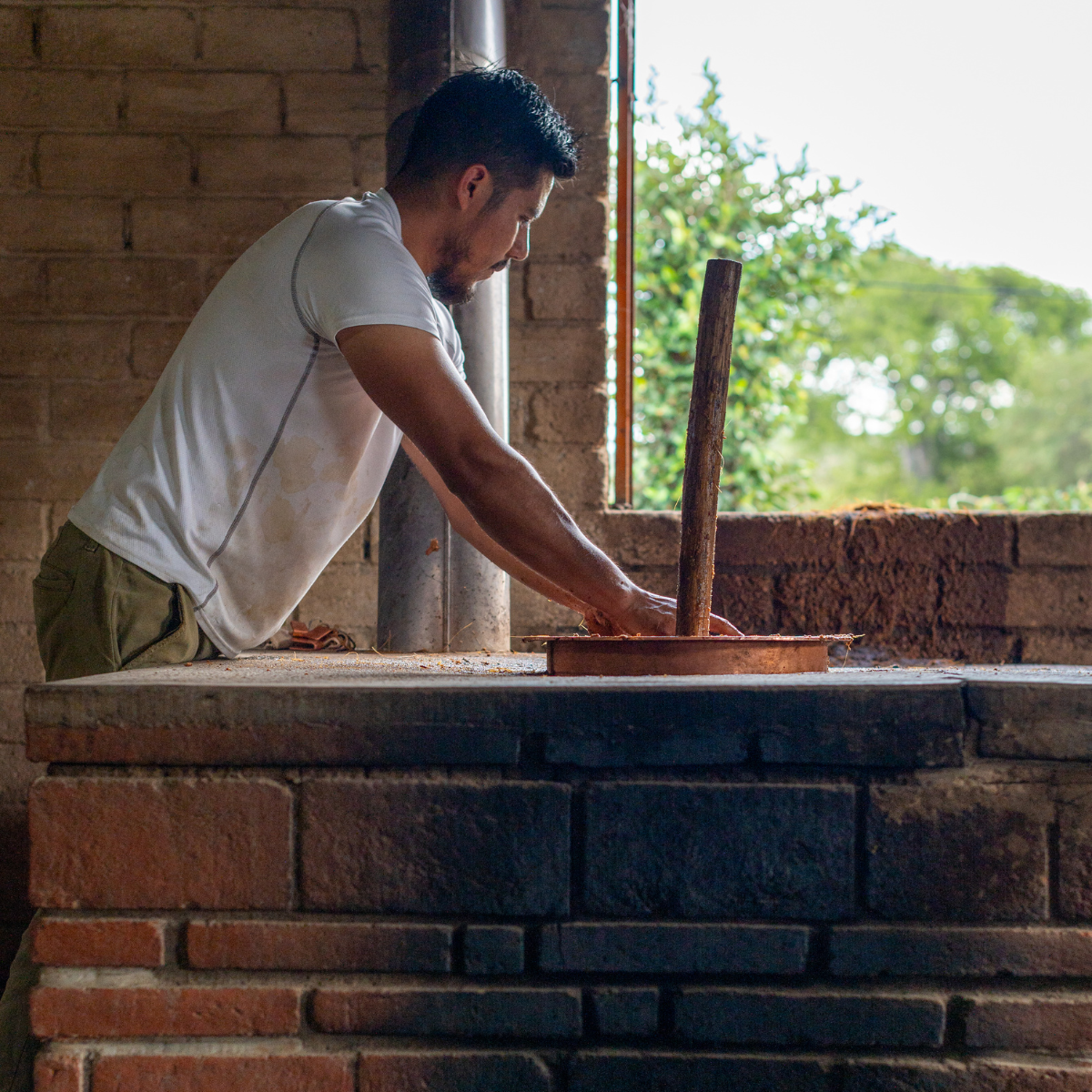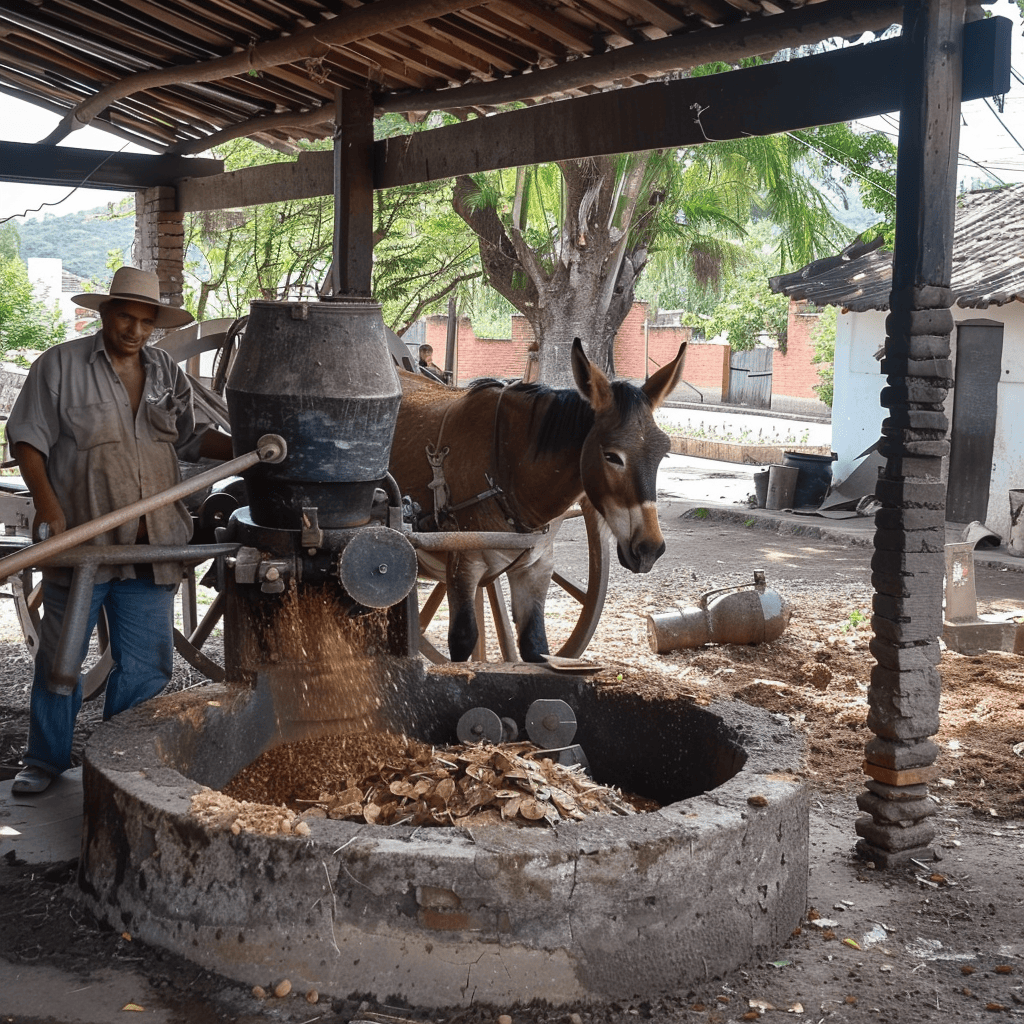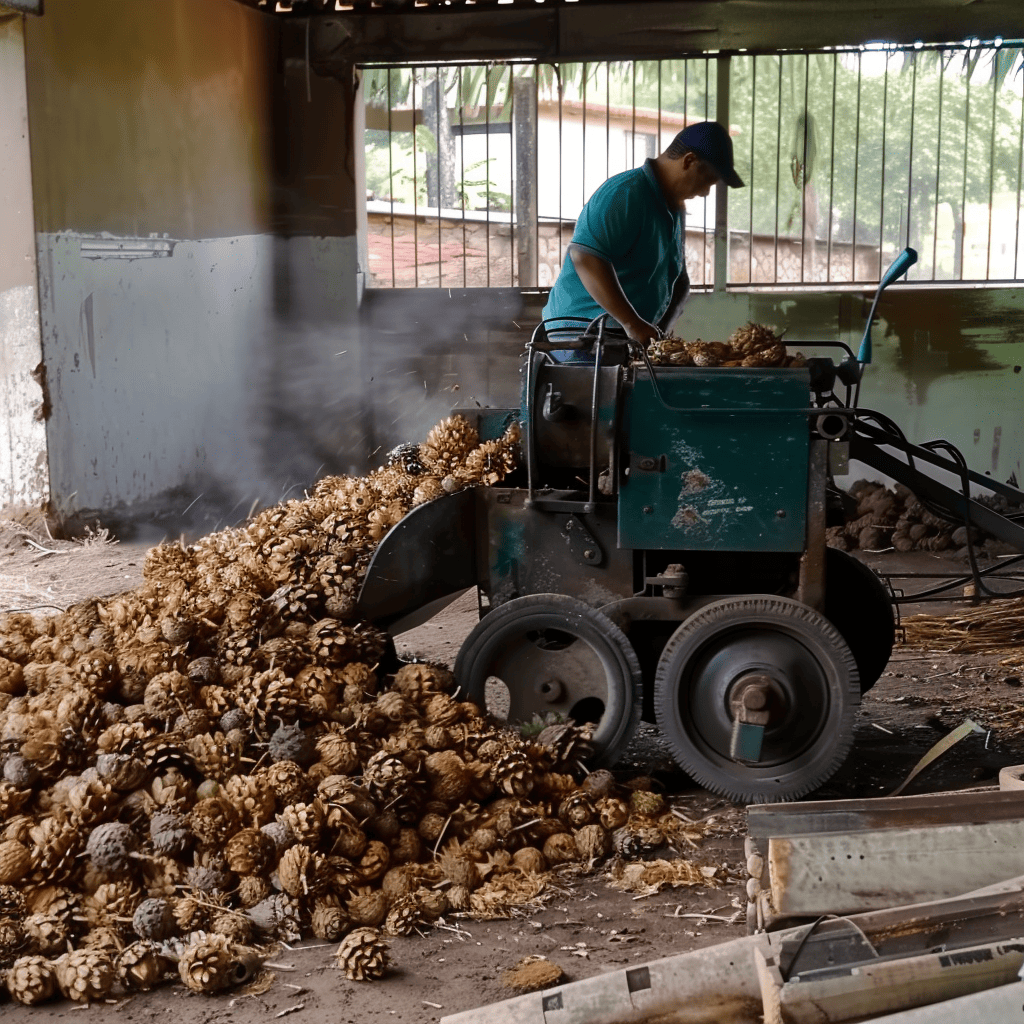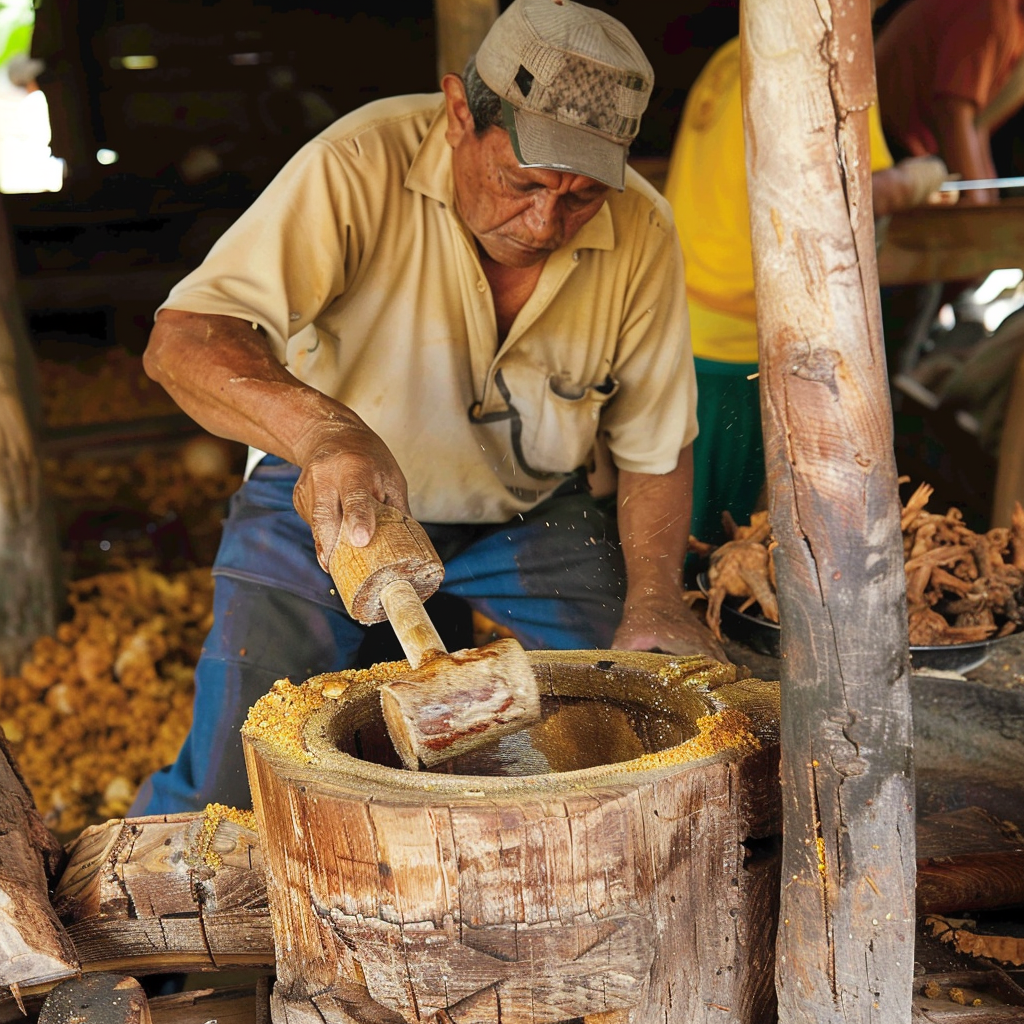Grinding Agave
The next step in the mezcal production process is grinding agave, a crucial stage known as “machucada.” This process releases the sugars trapped in the fibers of the cooked agave, making them available for fermentation. By breaking down the agave piñas, producers can ensure maximum extraction of these sugars, which directly influences the final mezcal’s flavor, aroma, and quality.
Grinding agave can be labor-intensive, and producers employ various methods to make the process more efficient. Some opt for mechanized options for speed and scale, while others stick to traditional methods that preserve the artisanal character of mezcal. The chosen grinding technique can significantly impact the final product’s flavor and production time, ranging from a few hours to several days.

Why Grinding Agave is Essential
Proper grinding of agave is more than just a technical step; it’s a critical part of mezcal production that determines the efficiency of fermentation. If the agave fibers are not adequately broken down, sugars remain trapped, reducing the potential yield and affecting the spirit’s overall quality. This stage also influences the complexity of mezcal’s flavor profile, as traditional methods often add unique characteristics that define the artisanal nature of the spirit.
Traditional and Manual Grinding Methods
Despite their labor-intensive nature, traditional grinding methods are highly valued for their ability to infuse mezcal with unique flavors and artisanal authenticity.
Here are two prominent conventional methods:
Tahona
- History: Tequila producers introduced the tahona, a large circular stone wheel, to Oaxaca in the 1980s.
- Process: Draft animals, such as donkeys, rotate the stone, crushing the cooked agave.
- Usage: Ideal for small-batch mezcal production, the tahona allows producers to maintain a hands-on approach that reflects the mezcal’s flavor.
- Time: Depending on the batch size, grinding with a tahona can take two to three days.
Wooden Mallets
- Description: This ancient technique manually crushes agave using heavy wooden mallets weighing 8 to 10 kilos each.
- Process: The agave is ground in pits, holes, or hollowed-out tree trunks that serve as mortars.
- Impact: This method is one of the oldest and most physically demanding, producing mezcal with deep, complex flavors that cannot be replicated with modern machinery.
- Time: Grinding with wooden mallets typically takes up to six days, reflecting the dedication of mezcaleros to traditional craftsmanship.

Mechanized Grinding Methods
Modern mechanized grinding methods are designed for efficiency and scalability, making them popular for larger-scale mezcal production.
Here are the two most common mechanized options:
Mechanical Mill
- Description: A mechanical mill uses steel rollers to crush the cooked agave and extract its juice.
- Efficiency: This method can process several tons of maguey piñas in just a few hours, making it ideal for large-scale operations.
- Impact on Mezcal: While efficient, the mechanical mill can lack the nuanced touch of traditional methods, producing a more uniform flavor.
Desgarradora
- Description: The desgarradora, or shredder, uses blades to tear apart the agave. It is powered by an internal combustion engine, typically gasoline.
- Usage: Designed for smaller batches, this method is slower than a mechanical mill, taking one to two days to complete.
- Advantages: Its mobility makes it a versatile option for producers who need to process agave in remote locations.
While mechanized options are efficient, many mezcal aficionados argue that traditional methods impart a distinct personality to the spirit.
The Rest and Saccharification Phase
After the grinding process, the agave transitions into the saccharification phase, an essential step in mezcal production that completes the transformation of starches into fermentable sugars. This phase is crucial for preparing the agave for fermentation, a subsequent process for converting these sugars into alcohol. Understanding the intricacies of saccharification sheds light on its vital role in producing high-quality mezcal.
The rest and saccharification phase involves:
- Cooling and Stabilization: After the agave is ground, the piñas need to cool down to stabilize the released sugars, which is crucial for the enzymatic breakdown. If the agave stays too hot, the necessary enzymes for sugar conversion could be denatured, leading to inefficiency. Cooling ensures that enzymatic activity can occur effectively.
- Hydrolysis Completion: The saccharification phase involves the hydrolysis of complex starches into simple sugars like fructose and glucose, thanks to natural enzymes in the agave. Water is added to help break down the starches into fermentable sugars, crucial for increasing yield during fermentation. More available sugars lead to more significant alcohol production potential.
- Enzymatic Activity: Enzymatic activity is crucial during saccharification, as natural enzymes like amylases break down starches and proteins in agave, fostering yeast and beneficial bacteria growth for fermentation. Utilizing high-quality, well-cooked piñas is essential, and factors such as temperature, pH level, and duration of this phase significantly impact conversion efficiency and the mezcal’s flavor profile.
- Preparing for Fermentation: Once the amylases have converted starches into simple sugars, the agave is ready for fermentation. Maintaining optimal conditions is essential to support yeast activity, allowing it to consume the sugars and produce alcohol, which involves controlling temperature and preventing contamination.
The saccharification phase is essential for preparing the agave for the next step in mezcal production: fermentation.
Duration of Saccharification
The duration of the saccharification phase can vary based on several factors, including the chosen method of production and the specific characteristics of the agave used. This phase may last anywhere from several hours to a few days. Traditional methods often involve a more extended period, allowing for a deep and comprehensive conversion of starches to sugars. In contrast, more mechanized approaches might seek to expedite this process, potentially sacrificing some complexity in flavor for efficiency.
The saccharification phase is essential for preparing the agave for the next step in mezcal production: fermentation.
Type of Mill | Approximate Duration |
Industrial Mill | 4 hours |
Mechanical Shredder | 12 hours |
Tahona (horse) | 2 days |
Tahona (oxen) | 3 days |
Wooden Mallet | 6 days |
Importance of Saccharification in Mezcal Quality
The saccharification phase is not merely a transitional step; it significantly influences the quality and characteristics of the final mezcal. A well-executed saccharification process enhances the flavor complexity of the spirit, laying a robust foundation for the fermentation phase. Traditional methods often used in this stage can impart unique qualities that distinguish artisanal mezcal from commercially produced spirits.
Balancing Tradition and Modern Efficiency
The choice of grinding method is a balancing act between preserving mezcal’s artisanal heritage and meeting the demands of modern production.
- Traditional Methods: Highlight regional flavors and emphasize authenticity, making them ideal for small-batch producers and mezcal enthusiasts who value craftsmanship.
- Mechanized Options: Provide scalability and consistency, catering to the growing global demand for mezcal.
Sustainability in Agave Grinding
As the mezcal industry continues to expand, the importance of sustainable practices in grinding and production methods is gaining attention. Key initiatives focus on energy efficiency, which involves optimizing mechanical processes to minimize fuel consumption. Additionally, there is a strong emphasis on preserving traditions by supporting small producers who rely on time-honored techniques. Ensuring that the use of draft animals and manual labor contributes to local economies and preserves cultural heritage is crucial for fostering community impact.
